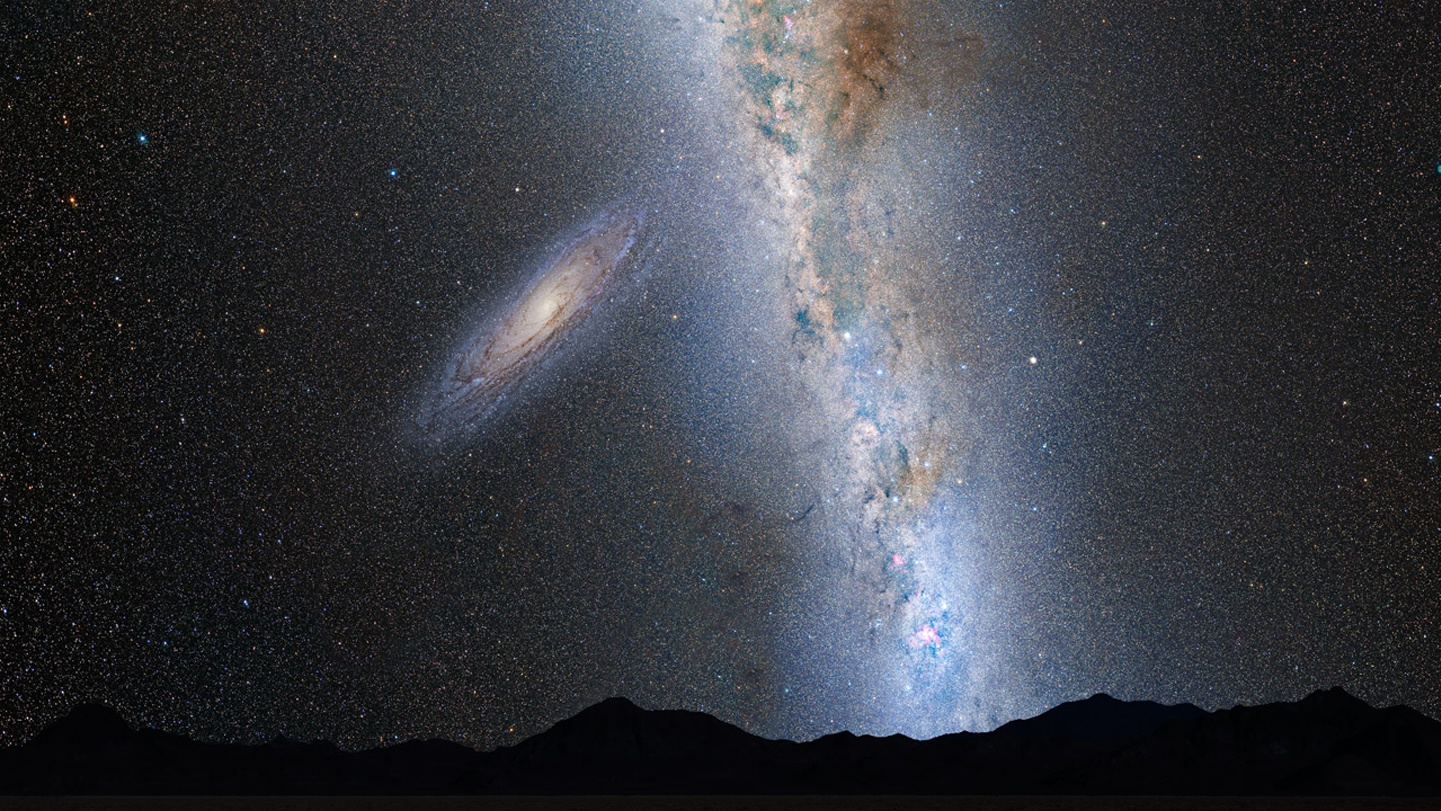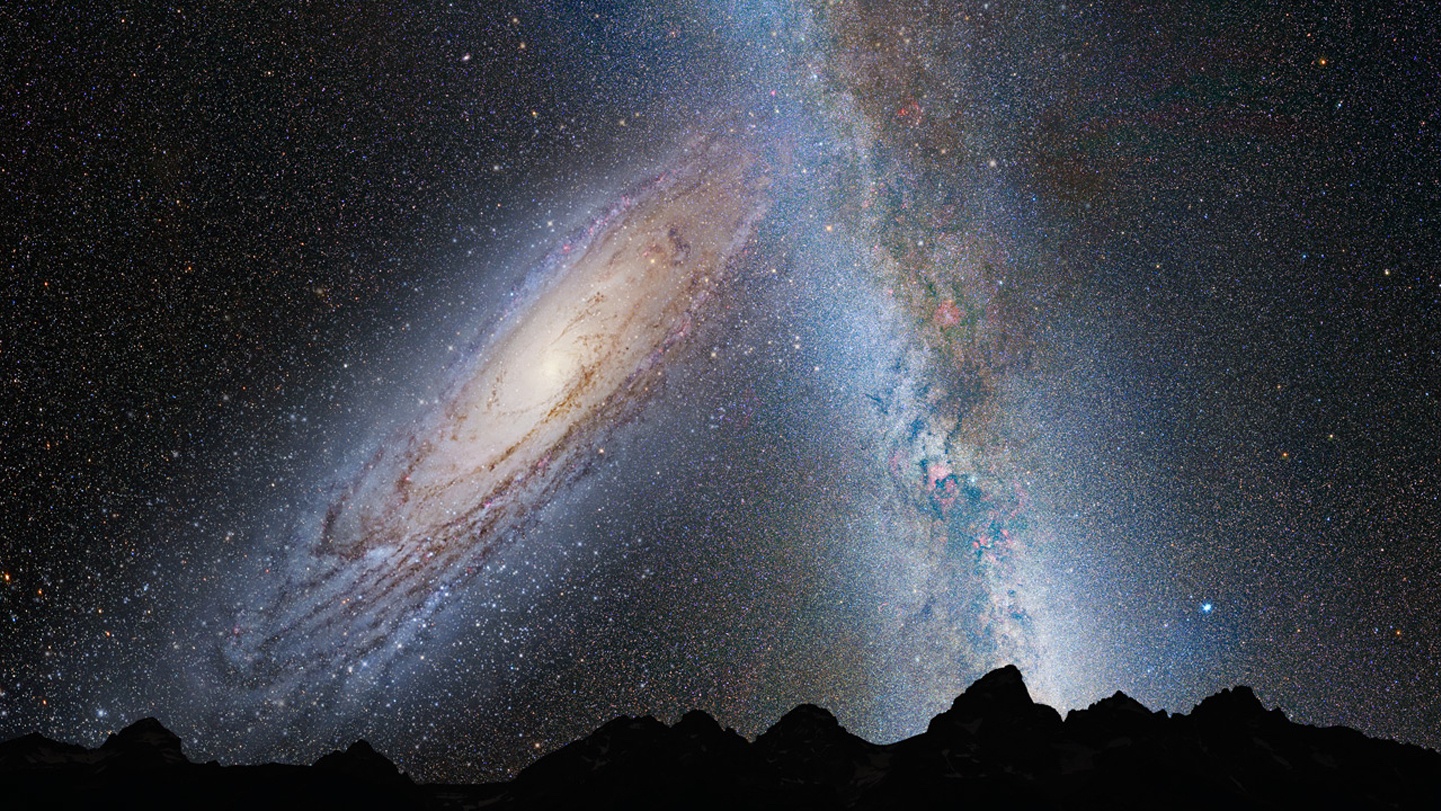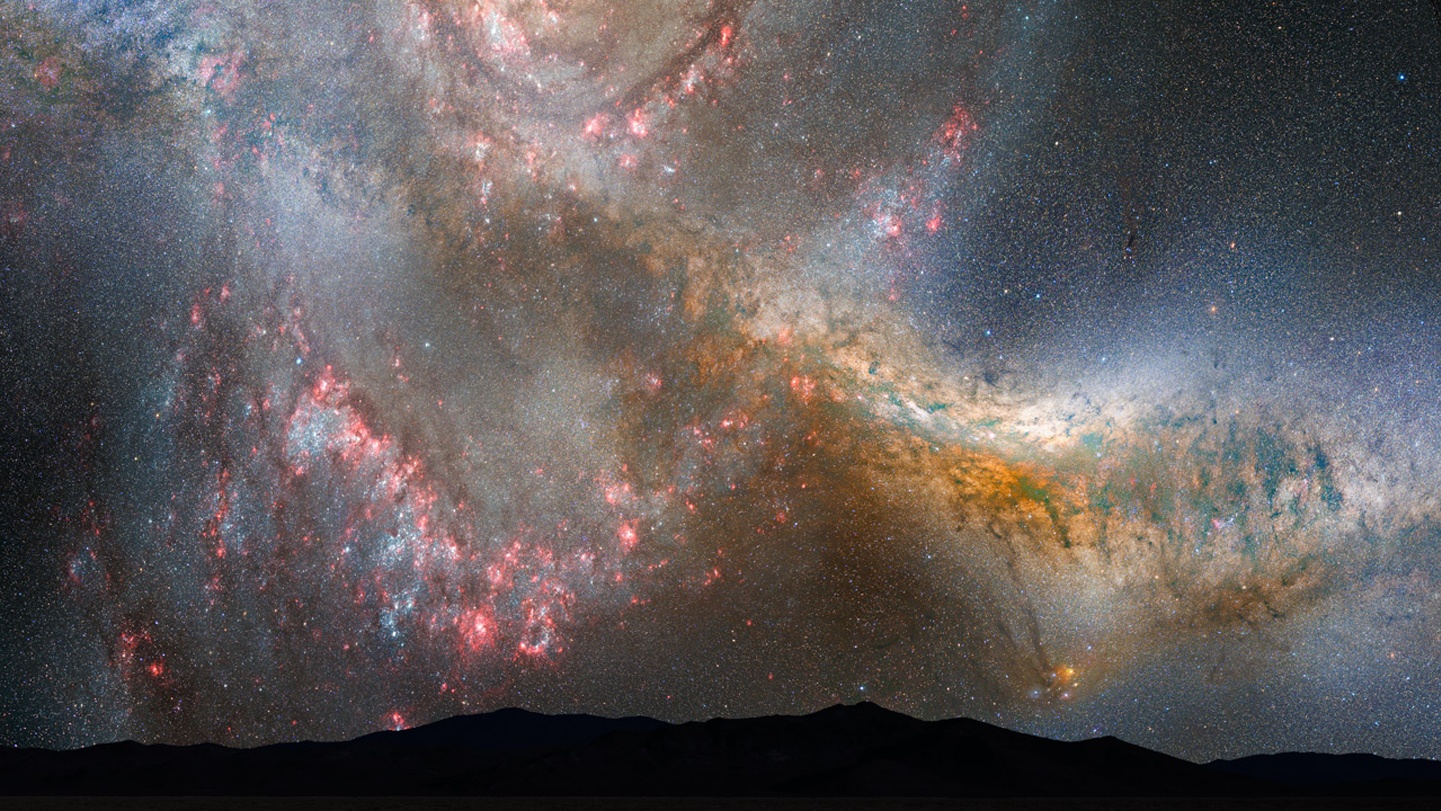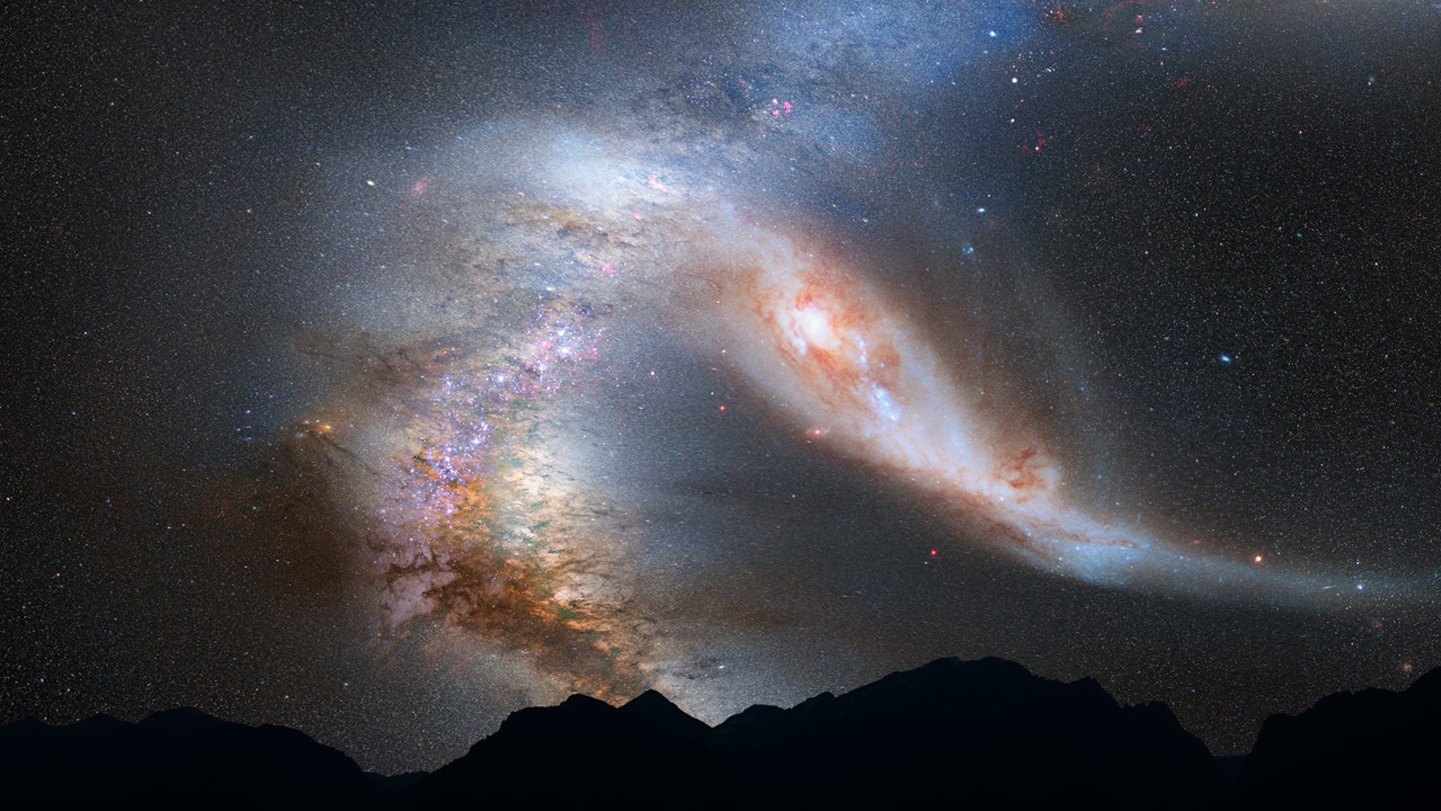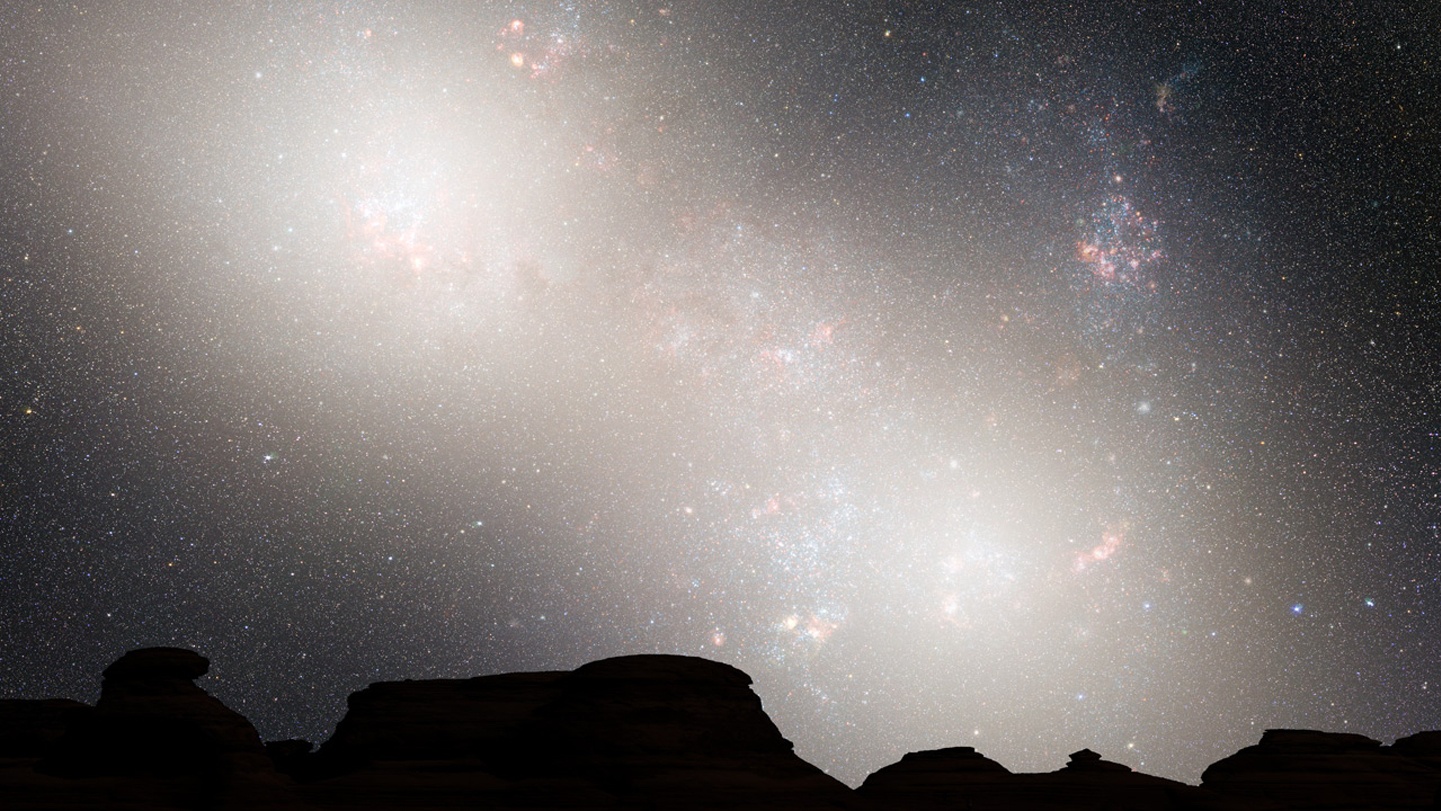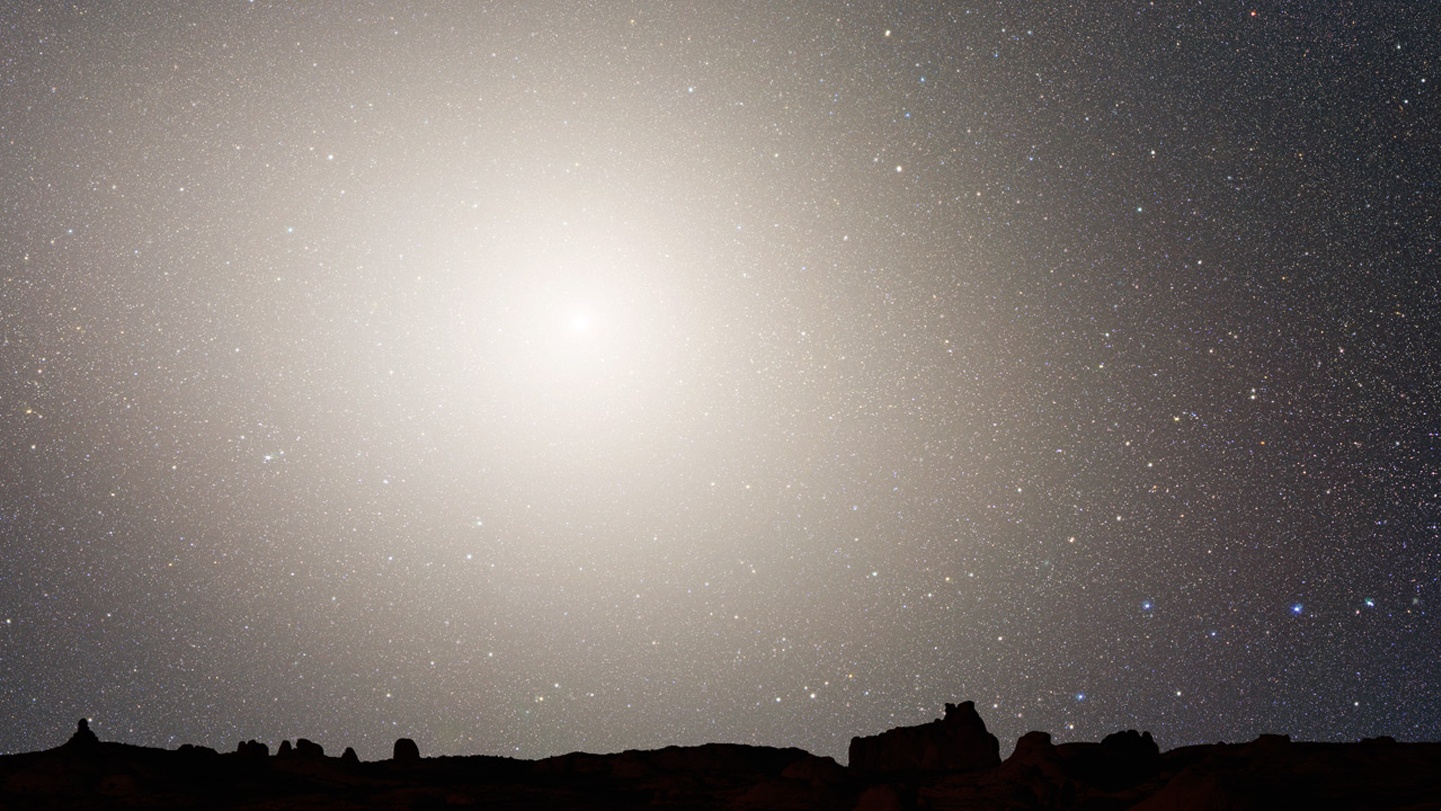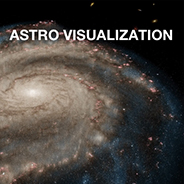Interactive Overview
Slider Interactive: A series of simulated images showing the same patch of sky over time as seen from Earth. Below the caption is a horizontal slider bar with six labeled stops and a solid white circle. Dragging the white circle right and left along the slider bar causes the image, labels, and caption to change. The change occurs gradually as one image, along with its associated captions and labels, fades out and the next fades in. A toggle button to the upper right of the image turns the image labels off and on. Labels are in the form of text with arrows pointing to specific features in the image.
Slider Stops
From left to right, the slider stops are labeled: 2 billion years, 3.75 billion years, 3.85 to 3.9 billion years, 4 billion years, 5.1 billion years, and 7 billion years.
Summary of Slider Stops
Sliding left to right reveals the following:
- “2 billion years” stop shows how the night sky will look in 2 billion years, with two galaxies close to each other but hardly touching. This is the initial image shown when the interactive is loaded.
- “3.75 billion years” stop shows the left galaxy appearing much larger in the night sky.
- “3.85 to 3.9 billion years” stop shows a portion of the distorted colliding galaxies taking up the majority of the night sky view.
- “4 billion years” stop shows what the two galaxies may look like after they pass through each other, their spiral shapes no longer distinguishable.
- “5.1 billion years” stop shows the galaxies as one bright, hazy diagonal line in the sky.
- “7 billion years” stop shows one bright elliptical galaxy in the center surrounded by a hazy white glow.
Stop 1: 2 billion years
Image Description: 2 billion years
Simulated image of a section of the dark night sky with the spiral-shaped Andromeda galaxy (left) and the relatively bright swath of the Milky Way galaxy (right). The two galaxies are close to each other but not obviously touching. Andromeda is a spiral-shaped disk angled on its side. It has a bright light brown and white core, and light blue edges. Brown dust lanes spiral from the center to the edges. The Milky Way forms a broad line from top to bottom, where it disappears behind the silhouette of a low mountain range. The top portion of the Milky Way consists of dim white cloud-like light with light brown filamentary structures. The bottom portion of the Milky Way is brighter and whiter. Within, above, and surrounding these two galaxies is a scattering of stars that look like small points of light.
Labels: 2 billion years
There are two text labels. On the left, the spiral-shaped disk is labeled “Andromeda.” On the right, the bright line running from top to bottom is labeled “Milky Way.”
Caption: 2 billion years
Two spiral galaxies, Andromeda and our Milky Way, hurtle toward each other at 250,000 mph, making Andromeda appear to grow larger.
Stop 2: 3.75 billion years
Image Description: 3.75 billion years
A simulated image of the same section of sky as the “2 billion years” stop, with the spiral-shaped Andromeda galaxy (left) and a relatively bright swath of the Milky Way (right). Andromeda appears about four times wider than in the “2 billion years” stop. The Milky Way still runs from top to bottom. The two galaxies are closer to each other, and the right side of Andromeda appears to be touching the dark, central portion of the Milky Way.
The top portion of the Milky Way consists of dim white cloud-like light with light brown filamentary structures. The bottom portion of the Milky Way is brighter and whiter. Andromeda has a bright brown-white core with light blue edges. Brown dust lanes spiral from the center to the edges. Within, above, and surrounding these two galaxies is a scattering of stars that look like small points of light.
The silhouette of the landscape of low mountains is different from the previous stop.
Labels: 3.75 billion years
There is one text label. The area between Andromeda and the Milky Way galaxies is labeled “Galaxy distortion begins.”
Caption: 3.75 billion years
Filling the night sky, the two galaxies’ shapes begin to be distorted by their mutual gravitational pull.
Stop 3: 3.85 to 3.9 billion years
Image Description: 3.85 to 3.9 billion years
Simulated image of the same section of the dark night sky with a silhouette of a mountain range at the bottom. Unlike in the “2 billion years” and “3.75 billion years” stops, the sky is unrecognizable with the Andromeda and Milky Way galaxies blending together. The entire sky is scattered with stars that look like small points of light, with some areas denser, brighter, and more colorful than others. Small clusters and strands of red appear on the left side of the image, while light-brown cloud-like regions are on the right side.
The silhouette of the mountain range is different from the previous stop.
Labels: 3.85 to 3.9 billion years
There are two text labels. In the top right of the image, above the light-brown cloud like region, the dense area with white points of light is labeled “Young star cluster.” In the bottom left, a red cluster is labeled “Star-formation region.”
Caption: 3.85 to 3.9 billion years
As stars of the two galaxies pass each other, colliding gas ignites storms of star formation.
Stop 4: 4 billion years
Image Description: 4 billion years
Simulated image of the same section of the dark night sky. Unlike in the prior “3.85 to 3.9 billion years” stop, the Milky Way and Andromeda galaxies are now distinguishable with the Milky Way on the left and Andromeda on the right. The two galaxies’ shapes are distorted compared to their forms in the “2 billion years” stop.
The Milky Way band, which was mostly straight in the “2 billion years” stop, is now curved from top to bottom before disappearing behind the mountain range. The top portion of the Milky Way consists of dim white cloud-like light, and the bottom portion has light brown filamentary structures and orange cloud-like light. In the middle of the galaxy, blue-white points of light are closely together against pink cloud-like clusters.
Andromeda, which had a strong spiral shape in the “2 billion years” stop, is now stretched out thinly across the sky. The galaxy has a somewhat lenticular shape, with the left side entangled with the upper portion of the Milky Way and a tail extending from the right side down toward the bottom right near the mountain range. Andromeda has a light brown and white core with light blue edges. Within, above, and surrounding these two galaxies is a scattering of stars that look like small points of light.
The silhouette of the mountain range is different from the previous stop.
Labels: 4 billion years
There are two text labels. The galaxy on the left is labeled “Milky Way.” The galaxy on the right is labeled “Andromeda.”
Caption: 4 billion years
The galaxies pass each other, emerging from their first close encounter with warped shapes.
Stop 5: 5.1 billion years
Image Description: 5.1 billion years
Simulated image of the same section of the dark night sky with a silhouette of a mountain range at the bottom. Unlike in the previous “4 billion years” stop, there is very little distinction between the two galaxies, and the view is overwhelmingly bright. The entire sky is scattered with stars that look like small points of light, some areas having denser and brighter clusters of white stars than others. A wide, bright, and hazy line takes up the majority of the sky. The line is diagonal, starting in the top left and falling behind the mountain range in the bottom right. There are two areas (top left and bottom right) that are the brightest within the swath. Moving away from the wide and bright area, the sky becomes gradually darker. Small pink and light blue clusters are faintly visible among the bright, cloud-like star-filled regions of the sky.
The silhouette of the mountain range is different from the previous stop.
Labels: 5.1 billion years
There are three text labels. The label in between the two galaxies, where a dense area of stars is located, is labeled “Both galaxies’ stars.” The bright white cloud-like region in the top left is labeled “Milky Way center.” The bright white cloud-like region in the bottom right is labeled “Andromeda center.”
Caption: 5.1 billion years
The galaxies’ spirals of gas and dust are depleted from star formation, leaving behind two bright cores.
Stop 6: 7 billion years
Image Description: 7 billion years
Simulated image of the same section of the dark night sky with a silhouette of a mountain range at the bottom. Unlike in the previous “5.1 billion years” stop that had two bright areas in the sky, there is only one bright area in this stop. A white circle is surrounded by a large, bright, and hazy cloud-like glow that takes up the majority of the view. The entire sky is scattered with stars that look like small points of light, with some areas denser, brighter, and whiter than others. Moving away from the wide and bright area, the sky becomes gradually and slightly darker.
The silhouette of the mountain range is different from the previous stop.
Labels: 7 billion years
There is one text label. The center of the bright white cloud-like region in the sky is labeled “New galaxy.”
Caption: 7 billion years
Milky Way and Andromeda are now merged as one huge new elliptical galaxy of mature stars.
